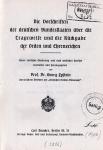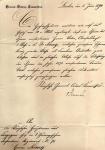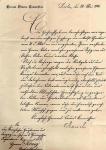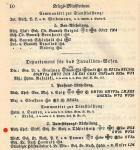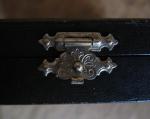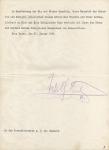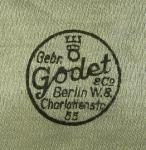-
Posts
1,291 -
Joined
-
Last visited
-
Days Won
20
Content Type
Profiles
Forums
Blogs
Gallery
Events
Store
Everything posted by Komtur
-

EK 1914 EK 2 precedence on mountings?
Komtur replied to Jaybo's topic in Germany: All Eras: The Iron Cross
For the regulations in imperial Germany of 1906 there is a summary of official rules by Prof. Dr. Georg Epstein, who also published the Deutscher Ordens Almanach. It is probable that the regulations for imperial Germany untill 1918 with the WWI decorations inklusive EK2 1914 are similar to these described in this 55 pages booklet. For most of the smaller German states there were no official regulations. Regards, Komtur. -
Hm, unfortunately I do not know this JOMSA article, would be really interesting for me. But again, the regulations are clear and I can show lots of portraits and some bars too, where a doctor got in order to these regulations: 1.) as military medical officer (army or navy), who was in the war in france = combat medal on combat ribbon (to be find in "Statut" from 20. Mai 1871) 2.) as military medical officer (army or navy), who stayed at home = noncombat medal on combat ribbon (to be find in "Allerhöchster Erlaß" No. 1 from 22. Mai 1871) 3.) as civil doctor (e. g. red cross as some foreign doctors too), who was in the war in france = noncombat medal on noncombat ribbon (to be find in "Allerhöchster Erlaß" No. 2 from 22. Mai 1871) Between these regulations there is no big gap and I do not know later different regulations. 1.), 2.) and 3.) are different groups of persons, so there was no change in regulations, but 2.) and 3.) where additionel groups. As always there are mistakes and exceptions, especially if there where about 1.1 Mio combat and about 0.4 Mio noncombat medals awarded. I could imagine, that there is one person with both versions, if he changed from one group to the other. That would be a possible construction for these cases. Kind regards, Komtur.
-
The ribbon on the 3rd position was removed before I got the fragment of this bar. What we see there is the under layer of the former ribbon. These under layers we find under the other three ribbons too and they are always the same as the original kind of ribbon over it. Therefore I suppose that the removed ribbon on the 3rd position was of light blue as its underlayer ribbon. Kind regards, Komtur.
-
IMHO that is not correct. All medical officers, who cross the border to france in the war, got the "normal" combattant medal an the combattant ribbon as all officers did (see scan of the regulations of this medal). Only a few medical officers, wich stayed at home, got the noncombattant medal on the combattant ribbon. Civil doctors, who cross the border to france in the war and served there in field hospitals, got the noncombattant medal on the noncombattant ribbon. Kind regards, Komtur.
-
Thanks for this idea At first I must admit, that in my opinion only the positions 1, 2 and 4 of this bar, I bought without any decoration, are absolutely clear because of the ribbons and the size of the impression of the medal and its ring. The Guelphen 4th class is logical because he was an Hannoverian and because of the light blue ribbon remains on the bar. But there are some Hannoverian medals of merit possible too. When I searched the rank lists of a person with the combination EK2w and HG4 I came to Oelker too. But he could have worn this combination only for a short time, because of his DAK to be seen in the rank list of 1874. Another point is the KDM70, that should be the combattant version for a military medical doctor. But happily I found another suspect: Wirklicher Geheimer Kriegsrath von Tschirschnitz. We find him with this combination in the rank list of 1889 (see scan). In the Ordensalmanach we find him with the CM, so he must has worn such a bar for about 8 years, if he added the CM in 1897, if not, until he died. Kind regards, Komtur.
-
1. EK2 - Prussian war time decoration 2. BMVO - Non-Prussian (Bavarian) war time decoration 3. Hanseatic cross - Non-Prussian (Hamburg) war time decoration 4. Frontkämpferehrenkreuz - Non-Prussian (German) war decoration 5. REO4 - Prussian peace time decoration 6. Red Cross Medall 3rd class - Prussian peace time decoration 7. DAK - Prussian peace time decoration 8. SAO knight 1st class with crown - Non-Prussian (Saxon) peace time decoration 9. CM - Prussian peace time decoration 10. Rumanian Jubilee Medal 1906 - foreign decoration May be I am wrong, but besides a switch of 8. with 9. seems everything in a logic precedence. Regards, Komtur.



